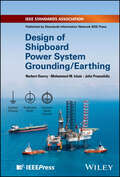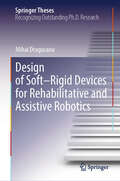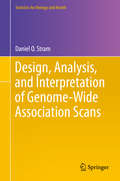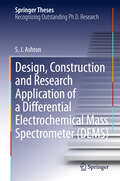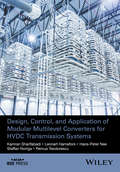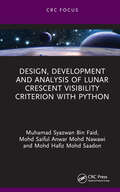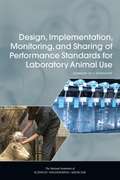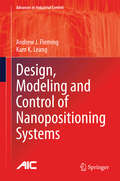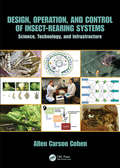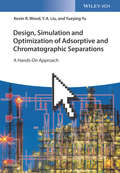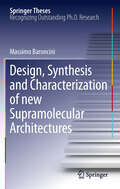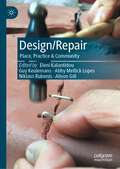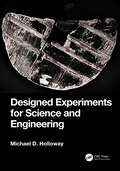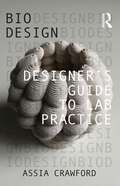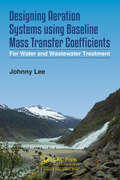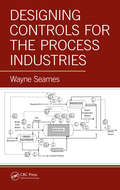- Table View
- List View
Design of Shipboard Power System Grounding / Earthing
by Mohammed M. Islam Norbert Doerry John ProusalidisThis book delves into the diverse prerequisites for grounding and earthing in contemporary ship power systems, addressing the evolving landscape of ship design influenced by power electronics The introduction of transformative technologies such as variable frequency drives and electric propulsion systems has heightened the complexity of shipboard grounding systems. This complexity necessitates accommodation for robust electronic systems, extending the focus beyond traditional grounding aspects to include common mode grounding and its profound design implications. Engineers now require a comprehensive guide to navigate the intricacies of shipboard electric power systems. To meet this imperative, Design of Shipboard Power System Grounding/Earthing provides an in-depth exploration of the subject. It offers a step-by-step initiation into the grounding process, supported by numerous case studies for enhanced comprehension. Aligned with both US and international standards, this book serves as an essential resource for engineers engaged in the design and implementation of shipboard power systems. Key highlights for readers encompass meticulous comparisons between terrestrial power system grounding and shipboard power grounding, as well as comprehensive discussions on high resistance grounding, shipboard AC system grounding requirements, DC system grounding, and more, including common mode grounding and earthing. The inclusion of abundant engineering drawings supports significant case studies, enhancing the practical application of the material. Designed to cater to a broad audience, Design of Shipboard Power System Grounding/Earthing is invaluable for readers involved with shipboard electrical systems, including shipbuilders, ship designers, ship operators, and those in regulatory bodies such as the Navy, USCG, ABS, among others. This resource is also well-suited for academicians, particularly final-year undergraduate and graduate students in marine electrical engineering programs.
Design of Smart Power Grid Renewable Energy Systems (Wiley - Ieee Ser.)
by Ali KeyhaniThe Updated Third Edition Provides a Systems Approach to Sustainable Green Energy Production and Contains Analytical Tools for the Design of Renewable Microgrids The revised third edition of Design of Smart Power Grid Renewable Energy Systems integrates three areas of electrical engineering: power systems, power electronics, and electric energy conversion systems. The book also addresses the fundamental design of wind and photovoltaic (PV) energy microgrids as part of smart-bulk power-grid systems. In order to demystify the complexity of the integrated approach, the author first presents the basic concepts, and then explores a simulation test bed in MATLAB® in order to use these concepts to solve a basic problem in the development of smart grid energy system. Each chapter offers a problem of integration and describes why it is important. Then the mathematical model of the problem is formulated, and the solution steps are outlined. This step is followed by developing a MATLAB® simulation test bed. This important book: Reviews the basic principles underlying power systems Explores topics including: AC/DC rectifiers, DC/AC inverters, DC/DC converters, and pulse width modulation (PWM) methods Describes the fundamental concepts in the design and operation of smart grid power grids Supplementary material includes a solutions manual and PowerPoint presentations for instructors Written for undergraduate and graduate students in electric power systems engineering, researchers, and industry professionals, the revised third edition of Design of Smart Power Grid Renewable Energy Systems is a guide to the fundamental concepts of power grid integration on microgrids of green energy sources.
Design of Soft–Rigid Devices for Rehabilitative and Assistive Robotics (Springer Theses)
by Mihai DragusanuThis book describes a comprehensive research project in which different devices for rehabilitation, assistance, and haptic applications are designed and developed. The fil-rouge is the user-centered perspective, that has been employed in all the design and development phases, and the exploitation of soft robotics solutions allowing for a safe and comfortable interaction with the user. Extensive information concerning the design, the practical application and the assessment of various assistive devices for upper limb are included throughout the book, which also offers an up-to-date reference guide for dealing with future interdisciplinary research projects involving soft robotics and user-centered perspectives for enhancing robotic assistance capabilities
Design of Supporting Systems for Life in Outer Space: A Design Perspective on Space Missions Near Earth and Beyond (Research for Development)
by Annalisa DominoniThis book is a rich source of information on design research and solutions for the support and development of space missions. International experiences and researches are presented in order to cast light on the role of space design in improving living and working conditions in outer space and to highlight the particularities of the necessary design skills, taking into account specific requirements and constraints. The challenge facing designers is how to approach environmentally extreme conditions in such a way that they are transformed from limitations into opportunities. The author has herself developed products that have been tested during on-orbit experiments on the International Space Station. Drawing on this unique experience and other case studies, the author proposes a new design methodology for space and demonstrates how the discipline of design is able to generate innovation thanks to the strong capacity of visioning. Ultimately this will lead to the development of further new equipment for astronauts that will facilitate space travel. While the book is intended primarily for students and researchers, it is also of interest for a broad readership attracted by space, innovation, and future scenarios.
Design of Thermal Oxidation Systems for Volatile Organic Compounds
by David A LewandowskiControlling the emission of volatile organic compounds (VOC) became a very prominent environmental issue with the passage of the 1990 Clean Air Act Amendments, and will continue to be an environmental priority through the next decade. No single technology has played as important a role in the control of VOC emissions as thermal oxidation. It has the ability to destroy VOCs in a one-step process that produces innocuous by-products.Design of Thermal Oxidation Systems for Volatile Organic Compounds provides all the information needed for developing a thermal oxidation design in a single reference. It covers design, operation, and maintenance as well as the principles behind the classification of volatile organic compounds as hazardous waste. The author explores the primary purpose of thermal oxidizers and discusses their limitations.The book provides:practical, complete, and concise thermal oxidizer design principlesan outline of state-of-the-art design principlesa practical rather than theoretical approachreal industrial examples in each chapterWith the new regulations that affect VOC emissions, engineers from such diverse fields as oil refining, chemical distillation and separation processes, and pharmaceutical industries will need to design and implement thermal oxidation systems. Design of Thermal Oxidation Systems for Volatile Organic Compounds provides a reference to the entire design process, from conceptualization to operation and maintenance.
Design of the Unfinished: A New Way of Designing Leftovers Regeneration (The Urban Book Series)
by Luciano CrespiThe book aims to provide city administrators and planners with a tool to accompany them in experimenting with the regeneration of no longer used parts of the built heritage, called leftovers, by adopting an innovative approach. A new and radically different form of project, with the task of proposing a new aesthetic code and a style of thought aimed at creating shelters for nomads of the third millennium.In the design field, the 21st century will be destined to measure itself against temporariness and precariousness, also in terms of aesthetic practices. Based on this hypothesis, the text identifies the design of the unfinished as the perspective for attributing to the leftovers a character, which is representative of the conditions of the just begun century. Through a transdisciplinary, exhibition-like and reversible approach, the elements of degradation of the existing work are welcomed in the project as a "gift", to be translated into a syntax aimed at giving form and meaning to the internal and external environments, with the inclusion of "additional components".
Design, Analysis, and Interpretation of Genome-Wide Association Scans
by Daniel O. StramThis book presents the statistical aspects of designing, analyzing and interpreting the results of genome-wide association scans (GWAS studies) for genetic causes of disease using unrelated subjects. Particular detail is given to the practical aspects of employing the bioinformatics and data handling methods necessary to prepare data for statistical analysis. The goal in writing this book is to give statisticians, epidemiologists, and students in these fields the tools to design a powerful genome-wide study based on current technology. The other part of this is showing readers how to conduct analysis of the created study. Design and Analysis of Genome-Wide Association Studies provides a compendium of well-established statistical methods based upon single SNP associations. It also provides an introduction to more advanced statistical methods and issues. Knowing that technology, for instance large scale SNP arrays, is quickly changing, this text has significant lessons for future use with sequencing data. Emphasis on statistical concepts that apply to the problem of finding disease associations irrespective of the technology ensures its future applications. The author includes current bioinformatics tools while outlining the tools that will be required for use with extensive databases from future large scale sequencing projects. The author includes current bioinformatics tools while outlining additional issues and needs arising from the extensive databases from future large scale sequencing projects.
Design, Construction and Research Application of a Differential Electrochemical Mass Spectrometer (DEMS)
by Sean James AshtonSean Ashton's doctoral thesis, which he finished at the Technical University in Munich, describes the challenge of constructing a Differential Electrochemical Mass Spectrometer instrument (DEMS). DEMS combines an electrochemical cell with mass spectrometry via a membrane interface, allowing gaseous and volatile electrochemical reaction species to be monitored online. The thesis carefully introduces the fuel cell electrocatalyst development concerns before reviewing the pertinent literature on DEMS. This is followed by the presentation and discussion of the new extended design, including a thorough characterization of the instrument. The capabilities of the new setup are demonstrated in two research studies: The methanol oxidation reaction on Pt and PtRu catalysts, and the electrochemical corrosion of fuel cell catalyst supports. Despite both topics having long since been studied, new insights can be obtained through careful investigations with the new DEMS instrument that are of great, general interest. The thesis and the instrument thus show the way for future investigations in the field.
Design, Control and Application of Modular Multilevel Converters for HVDC Transmission Systems
by Remus Teodorescu Hans-Peter Nee Steffan Norrga Kamran Sharifabadi Lennart HarneforsDesign, Control and Application of Modular Multilevel Converters for HVDC Transmission Systems is a comprehensive guide to semiconductor technologies applicable for MMC design, component sizing control, modulation, and application of the MMC technology for HVDC transmission. Separated into three distinct parts, the first offers an overview of MMC technology, including information on converter component sizing, Control and Communication, Protection and Fault Management, and Generic Modelling and Simulation. The second covers the applications of MMC in offshore WPP, including planning, technical and economic requirements and optimization options, fault management, dynamic and transient stability. Finally, the third chapter explores the applications of MMC in HVDC transmission and Multi Terminal configurations, including Supergrids. Key features: Unique coverage of the offshore application and optimization of MMC-HVDC schemes for the export of offshore wind energy to the mainland. Comprehensive explanation of MMC application in HVDC and MTDC transmission technology. Detailed description of MMC components, control and modulation, different modeling approaches, converter dynamics under steady-state and fault contingencies including application and housing of MMC in HVDC schemes for onshore and offshore. Analysis of DC fault detection and protection technologies, system studies required for the integration of HVDC terminals to offshore wind power plants, and commissioning procedures for onshore and offshore HVDC terminals. A set of self-explanatory simulation models for HVDC test cases is available to download from the companion website. This book provides essential reading for graduate students and researchers, as well as field engineers and professionals who require an in-depth understanding of MMC technology.
Design, Development and Analysis of Lunar Crescent Visibility Criterion With Python
by Muhamad Syazwan Faid Mohd Saiful Nawawi Mohd Hafiz SaadonThe analysis of lunar crescent visibility criterion is vital in providing a comparative insight for predicting the visibility and suitability for Hijri calendar determination. While there have been previous attempts to measure the performance of lunar crescent visibility criterion, these attempts only apply to a singular analysis and not a comparative examination.Design, Development and Analysis of Lunar Crescent Visibility Criterion with Python explores the development of an analysis tool for lunar crescent visibility criterion using an integrated lunar crescent visibility database. The analysis tool, called HilalPy and HilalObs, was developed in the form of a Python library, so that it can be integrated into other software and webpages to enable deployment into various operating systems. This book will provide useful insights for the future development of lunar crescent visibility criterion, particularly for calendrical purposes.Key Features:● Presents an analysis tool for lunar crescent visibility based on an integrated lunar crescent report database.● Offers researchers and practitioners the capability to perform comparative analyses of the percentage of reliability in lunar crescent visibility criteria, thereby contributing to the construction of robust criteria for determining the Hijri calendar.● Provides a comprehensive resource for researchers, students, policymakers, and practitioners involved in the determination of the Hijri calendar.
Design, Implementation, Monitoring, and Sharing of Performance Standards for Laboratory Animal Use: Summary of a Workshop
by Joe AlperIn order to better understand the critical issues pertaining to the concept of performance standards for laboratory animal use, the Institute for Laboratory Animal Research Roundtable on Science and Welfare in Laboratory Animal Use held a public workshop on April 20-21, 2015. The purpose of the workshop was to promote the appropriate and responsible care of animals in research, to provide a balanced and civil forum for discussion and collaboration, and to help build transparency and trust among stakeholders. Participants addressed the challenges of defining, developing, implementing, assessing, and validating performance standards to ensure "optimal practices, management, and operations. " This report summarizes the presentations and discussions from the workshop.
Design, Make, Play: Growing the Next Generation of STEM Innovators
by Margaret Honey David E. Kanter"Design, Make, Play: Growing the Next Generation of STEM Innovators is a resource for practitioners, policymakers, researchers and program developers that illuminates creative, cutting edge ways to inspire and motivate young people about science and technology learning. The book is aligned with the National Research Council's new Framework for Science Education, which includes an explicit focus on engineering and design content, as well as integration across disciplines. Extensive case studies explore real world examples of innovative programs that take place in a variety of settings, including schools, museums, community centers, and virtual spaces. Design, Make, and Play are presented as learning methodologies that have the power to rekindle children's intrinsic motivation and innate curiosity about STEM (science, technology, engineering, and mathematics) fields. A digital companion app showcases rich multimedia that brings the stories and successes of each program's and the students who learn there's to life"--
Design, Modeling and Control of Nanopositioning Systems
by Andrew J. Fleming Kam K. LeangCovering the complete design cycle of nanopositioning systems, this is the first comprehensive text on the topic. The book first introduces concepts associated with nanopositioning stages and outlines their application in such tasks as scanning probe microscopy, nanofabrication, data storage, cell surgery and precision optics. Piezoelectric transducers, employed ubiquitously in nanopositioning applications are then discussed in detail including practical considerations and constraints on transducer response. The reader is then given an overview of the types of nanopositioner before the text turns to the in-depth coverage of mechanical design including flexures, materials, manufacturing techniques, and electronics. This process is illustrated by the example of a high-speed serial-kinematic nanopositioner. Position sensors are then catalogued and described and the text then focuses on control. Several forms of control are treated: shunt control, feedback control, force feedback control and feedforward control (including an appreciation of iterative learning control). Performance issues are given importance as are problems limiting that performance such as hysteresis and noise which arise in the treatment of control and are then given chapter-length attention in their own right. The reader also learns about cost functions and other issues involved in command shaping, charge drives and electrical considerations. All concepts are demonstrated experimentally including by direct application to atomic force microscope imaging. Design, Modeling and Control of Nanopositioning Systems will be of interest to researchers in mechatronics generally and in control applied to atomic force microscopy and other nanopositioning applications. Microscope developers and mechanical designers of nanopositioning devices will find the text essential reading.
Design, Operation, and Control of Insect-Rearing Systems: Science, Technology, and Infrastructure
by Allen Carson CohenDesign, Operation, and Control of Insect-Rearing Systems: Science, Technology, and Infrastructure explains the fundamental components of insect rearing: 1) the rearing systems, per se 2) personnel 3) education of rearing personnel 4) communication of procedures 5) an in-depth look at silkworm rearing 5) facilities where rearing is conducted, and 6) funding for all these components. Insect rearing serves a wide array of purposes, including research, pest control by sterile insect technique and biological control, production of insects as food for other animals, conservation, education, and even far-reaching technology where insects are used to produce products such as pharmaceutical materials and strong, multipurpose textiles. This book surveys and analyzes insect rearing from a scientific and technology-based approach. At its foundation, this approach assumes that rearing systems are complex interactions of components that can be understood and controlled by using a mechanistic approach. Author Allen Carson Cohen explains the infrastructure of rearing systems, their current status and character, and what kind of changes can be made to improve the field of insect rearing. Two Appendices republish out-of-print monographs that provide fascinating historical context to the development of the insect-rearing systems we have today.
Design, Simulation and Optimization of Adsorptive and Chromatographic Separations: A Hands-On Approach
by Y. A. Liu Kevin R. Wood Yueying YuThis book allows the reader to effectively design, simulate and optimize adsorptive and chromatographic separations for industrial applications. To achieve this, a unified approach is presented, which develops the ideal and intermediate equations necessary, while simultaneously offering hands-on case studies employing the rigorous simulation packages Aspen Adsorption and Aspen Chromatography. The first part of the book deals with design strategies, detailed design considerations and the assumptions, which the models are allowed to make and covers shortcut design methods as well as mathematical tools to determine optimal operating conditions. These insights are used in Chapter 4 & 5 to estimate and optimize performance parameters, such as purity, recovery, etc. as well as the regression of these parameters.
Design, Synthesis and Applications of One-Dimensional Chalcogenide Hetero-Nanostructures
by Tao-Tao ZhuangThis thesis focuses on the design and synthesis of novel one-dimensional colloidal chalcogenide hetero-nanostructures for enhancing solar energy conversion applications. Semiconducting nanomaterials are particular attractive for energy conversion due to the quantum confinement effects dictating their unique optical and electronic properties. Steering the photo-induced charge-flow based on unique bandgap alignment in semiconductor heterojunctions is critical for photo-electric/chemical conversion.The author presents the controllable preparation strategies to synthesize 1D chalcogenide hetero-nanostructures with various fine structures, further been used as excellent template materials for preparing other novel and complex hybrid architectures through a series of chemical transformations. The heterogeneous growth mechanisms of novel hetero-nanostructures is studied for developing a facile and general method to prepare more novel heterostructures. The band gap structure simulations, detailed charge carrier behaviour and unique solar energy conversion properties of the prepared hybrid nanostructures are deeply investigated. This work would open a new door to rationally designing hybrid systems for photo-induced applications.
Design, Synthesis and Characterization of new Supramolecular Architectures
by Massimo BaronciniThis thesis focuses on the bottom-up design, construction and operation of supramolecular systems capable of behaving as devices and machines on the molecular scale, which is a topic of great interest in nanoscience and a fascinating challenge in nanotechnology. In particular, the systems investigated here include: polyviologen dendrimers capable of behaving as hosts and chargestoring devices; molecular machines based on pseudorotaxanes/rotaxanes and operated by photoinduced proton transfer, or photoisomerization reactions; and a simple unimolecular multiplexer/demultiplexer. The systems have been characterized using a variety of techniques including absorption and emission spectra, laser flash photolysis, NMR spectroscopy, electrochemical experiments, stopped flow measurements. This research addresses a large number of open problems in the nanosciences, dealing with a wide range of the most advanced applications of supramolecular systems.
Design, Synthesis, and Properties of Redox-Active Bisquinodimethanes (Springer Theses)
by Takashi HarimotoThis book focuses on the construction of redox systems composed of doubly fused para-quinodimethane (p-QD) units and on the elucidation of the unique redox behavior. p-QD is a class of non-aromatic π-conjugated compounds that is well-known to be interconvertible scaffolds in many response systems due to its contribution of resonance structure with a planar aromatic sextet ring. This book describes studies on a strategy for precisely controlling the frontier orbital levels of p-QD-based redox systems and a nature of cationic states of π-electron systems with doubly fused p-QD units. The author revealed that multi-redox unimolecular systems with cross-linking of the two sterically strained p-QD units exhibit unique hysteretic character or have a domino effect upon electron transfer, which cannot be achieved in a monomeric p-QD-based system. Thus, these studies are milestones in creating functional redox systems unprecedented dynamic redox (dyrex) behaviors. A study on cationic states of π-electron systems with doubly fused p-QD units and their intrinsic redox properties will lead to the development of unprecedented dyrex systems, the frontier orbital levels of which can be precisely controlled by input of external stimuli such as electric potential and heat. This book benefits chemists with a deeper understanding of the redox-active molecules.
Design/Repair: Place, Practice & Community
by Alison Gill Eleni Kalantidou Guy Keulemans Abby Mellick Lopes Niklavs RubenisThis collection of essays sheds light on repair as a disposition to material culture and a practice rooted in diverse sociocultural experiences. It provides an in-depth exploration of how repair manifests itself through the different lenses of governance, grassroots activism, transformative design and community-led initiatives. Most importantly, the chapters demonstrate how place-based approaches can reveal blueprints for social impact in circumstances of growing environmental and social precariousness.
Designed Experiments for Science and Engineering
by Michael D. HollowayDesigned Experiments for Science and Engineering is a versatile and overarching toolkit that explores various methods of designing experiments for over 20 disciplines in science and engineering.Designed experiments provide a structured approach to hypothesis testing, data analysis, and decision‑making. They allow researchers and engineers to efficiently explore multiple factors, interactions, and their impact on outcomes, ultimately leading to better‑designed processes, products, and systems across a wide range of scientific and engineering disciplines. Each discipline covered in this book includes the key characteristics of the steps in choosing and executing the experimental designs (one factor, fractional factorial, mixture experimentation, factor central composite, 3‑factor + central composite, etc.) and reviews the various statistical tools used as well as the steps in how to utilize each (standard deviation analysis, analysis of variance [ANOVA], relative standard deviation, bias analysis, etc.).This book is essential reading for students and professionals who are involved in research and development within various fields in science and engineering, such as mechanical engineering, environmental science, manufacturing, and aerospace engineering.
Designer Animals
by Conrad Brunk Sarah HartleyDesigner Animals is an in-depth study of the debates surrounding the development of animal biotechnology, which is quickly emerging out of the laboratory and into the commercial marketplace. This book innovatively combines expert analysis on the technology's economic, professional, ethical, and religious implications while remaining firmly grounded in the 'real world' political environment in which the issue is played out. Designer Animals uses non-technical language to explore the science behind animal biotechnology and the ethical frameworks at play in its surrounding debates. By investigating the interests of major stakeholders, including researchers on the cutting edge of science; mainstream and 'alternative' agriculture organizations; the animal welfare movement; and health care providers, patients, and researchers, the contributors illuminate the most important points of agreement and disagreement on this hotly contested topic.
Designer’s Guide to Lab Practice (Bio Design)
by Assia CrawfordThis book explores the growing field of bio-design through interdisciplinary creative practice. The volume illustrates a range of experimental working techniques while offering a foundational understanding of lab practice principles. The book highlights the myriad of opportunities presented by microorganisms that have reshaped the planet and made it habitable. The book provides an account of the creation of living materials from the point of view of an architectural design practitioner. The transition from traditional design practice to laboratory investigation is captured, highlighting strategies of creating partnerships across a range of fields. The book demonstrates laboratory methods and ways of investigating the development of living materials and celebrates the growing body of practitioners, scientists, activists and anthropologists who are reimagining new strategies for addressing contemporary environmental challenges. Designer's Guide to Lab Practice looks at ways in which integrating living components with needs of their own would not only help offset the environmental impact that we have on our planet but could also create a closer relationship with nature. It is a working manual as well as a guide to emerging practitioners seeking to transition into a field that is yet to be defined and that offers the promise of a new era of human habitat making as a direct response to the looming ecological crisis.
Designing Aeration Systems using Baseline Mass Transfer Coefficients: For Water and Wastewater Treatment
by Johnny LeeThe book is about the discovery of a Standard Specific Baseline Mass Transfer Coefficient (KLa0)20 that represents a revolutionary change in the understanding, designing, and operation of aeration equipment, as well as providing a baseline for future research and development for water and wastewater treatment systems. It discusses the use of the Standard Model for oxygen transfer to determine the baseline, and its major finding is to show that the gas transfer model is a consistent relativistic theory of molecular interactions. Previously, the challenge was the appearance of divergences in the mass transfer coefficient estimations that defies aeration design. This normalization to a baseline is a great achievement in physics and engineering.
Designing Bioactive Polymeric Materials For Restorative Dentistry
by Mary Anne S. MeloRestorative biomaterials in dentistry are designed to restore the shape and function of teeth. Their applicability is related to restorative procedures such as dental restorations, dentures, dental implants, and endodontic materials. Designing Bioactive Polymeric Materials for Restorative Dentistry reviews the current state of the art for restorative biomaterials and discusses the near-future trends in this field. The book examines the biomaterials utilized in restorative dental applications (bonding, composites, cements, and ceramics) and assesses the design for these materials and the role of nanotechnology. All of the contributors are active clinical dentists and researchers in this field. FEATURES Overviews the major ongoing research efforts on developing bioactive bonding systems and composites in dental biomaterials Focuses on emerging trends in restorative dental biomaterials Incorporates evidence-based data on new restorative dental materials throughout the book Features extensive references at the end of each chapter to enhance further study Mary Anne S. Melo, DDS, MSc, PhD FADM, is an Associate Professor and Division Director of Operative Dentistry at the School of Dentistry, University of Maryland, Baltimore, Maryland.
Designing Controls for the Process Industries
by Wayne Seames<p>Offering a modern, process-oriented approach emphasizing process control scheme development instead of extended coverage of LaPlace space descriptions of process dynamics, this text focuses on aspects that are most important for process engineering in the 21st century. Instead of starting with the controller, the book starts with the process and moves on to how basic regulatory control schemes can be designed to achieve the process’ objectives while maintaining stable operations. In addition to continuous control concepts, process and control system dynamics are embedded into the text with each new concept presented. <p>The book also includes sections on batch and semi-batch processes and safety automation within each concept area. It discusses the four most common process control loops—feedback, feedforward, ratio, and cascade—and discusses application of these techniques for process control schemes for the most common types of unit operations. It also discusses more advanced and less commonly used regulatory control options such as override, allocation, and split range controllers, includes an introduction to higher level automation functions, and provides guidance for ways to increase the overall safety, stability, and efficiency for many process applications. It introduces the theory behind the most common types of controllers used in the process industries and also provides various additional plant automation-related subjects.</p>
